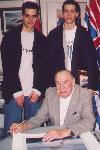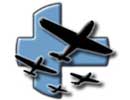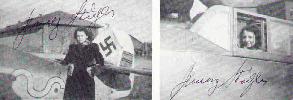I Met Franz Stigler
Quick quide to this page:
Interview by Blitz |
Interview by Paetn |
Submarine episode |
Evacuation from Tunisia |
Enemy was a friend |
More information |
About this www-page ]
I met Franz Stigler by Blitz, Canada.
Blitz had the honor to meet the famous German ace Franz Stigler in January 2001. He wrote report of the meeting and the various answers by the pilot. Mr. Stigler is well known and respected from an unusual act of war - he refused to shoot down a heavily damaged B-17 bomber, and escorted it towards home. This act of chivalry was a mystery for a long time, until in 1990 it was found out that Stigler was the german pilot in question - and he was brought to meet the B-17 crew, securing suddenly a place amongst the fighter pilot legends.
Well I gotta say I was a complete BLAST meeting Franz. It was a perfect setting. Informal small local retail store with at most only about 7 people there. In other words I spent about 1 hour 1/2 just talking to him. Drilling him with questions and being in general just awinspired that I was actually talking to a ME109 ACE with 28 kills 5 four mots and a guy with plenty of stick time in the first operational jet the ME262. He's a great guy to just talk to (which he did willingly). Below are the questions that I fired at him and the summary (not direct quotes since I didn't record anything) of what he responded back to me. Its all anticdotal evidence but hey at least you can say its a primary source and straight from the "horses mouth" persay. Enjoy.
What was your favorite 109?
 The F version was my favorite. It was not nearly as sluggish in the controls as the G version was. It was best suited as a Dogfighter. The G6 however was better at higher altitudes and had a higher ceiling than the F's.
The F version was my favorite. It was not nearly as sluggish in the controls as the G version was. It was best suited as a Dogfighter. The G6 however was better at higher altitudes and had a higher ceiling than the F's.
When you fired your guns, did u shoot them separately or together?
The stick had 2 different buttons, one for the cannon and on for the machine gun. You flipped open a cover for the cannon before firing, and waited till the enemy was within 200ft, and within the 2 rings on the REVI Gun sight (letting the fighter drift through the center). Both guns were fired at the same time at that range.
Are the stories true, that the 109 had weak wings and would loose them easily?
He has never heard of a 109 loosing its wings from his experience or others. The wings could withstand 12 g's and since most pilots could only handle at most 9 g's there was never a problem. He was never worried about loosing a wing in any form of combat.
Did most of the 109's have MW-50 or GM-1?
Of all the 109G's he ever saw and flew, all had Water Methanol injection. This could be used in combat for up to about 2 min. any further use would have resulted in the engine being damaged and needing replacement upon landing. The F's did not have this boost system. It helped pilots in emergency situations in catching up to fighters or running away from them.
Did you fly the 109 with the wing-mounted guns?
Yes he had, but almost everyone he new got the guns removed (including himself). The 109 handled much worse at low speeds with the guns on the wings, but climb was similar. It only really added some weight to the a/c.
What's the fastest you ever had a 109 in a dive?
I've taken it to about 680 to 750 km/hr at which point you needed 2 hands to pulls it out of the dive.
Did pilots like the slats on the wings of the 109?
Yes, pilots did like them, since it allowed them better positions in dogfights along with using the flaps. These slats would also deploy slightly when the a/c was reaching stall at higher altitudes showing the pilot how close they were to stalling.....this was also useful when you were drunk
Did pilots like the tracers or did some not use them?
Every third round was a tracer round and most pilots he new used them. However they were not used to aim. The tracer round always had less of an arc than the actual bullet. So if the pilot aimed using the tracers the bullets would all miss. A good pilot used the gun sight and always waited till they were at close range.
What other types of planes did you fly?
He flew the ME262 on many missions near the end of the war and likes its speed most of all. The engines had to be overhauled every 20 hours, and the a/c was sluggish in its controls at low and very high speeds. To many it was hard to switch to a new aircraft after flying only one type for so many years. The huge speed advantage made it difficult to do passes on bombers as they would always end up overshooting the formation since they came in too fast. It took some getting used too.
On landing they were very vulnerable however and used 190's to cover them. The stick controls at low speeds was bad, and the engines had to be throttled very far back to prepare for landing. He also regularly flew the Ju87 to visit his girlfriend at night. It was very forgiving in its flight characteristics and had very good maneuverability. The 190 was over all a better a/c than the 109, but again the pilots liked the 109's climb and simply the fact that by the time they had flown 400 combat missions the 109 had become very very familiar to them. He also flew a 110, which he thought was sluggish and made for a large target for fighters. Franz also said he once flew a 4-engine flying boat. Fanz Stigler liked the 109G as well and also enjoyed flying the K-4. The K-4, he said was very much like the G yet could leave all other fighters behind in climb. In control feel he said the K felt identical to the G. He described on many occasions where they would just bank away from the fighters and climb away from them (my guess this is probably after attacking them?)He also flew a Spitfire once, saying that he liked the a/c.
How did the cockpit feel in the 109?
The cockpit was small, but one got used to it after a while. In the end it felt comfortable since you felt like part of the plane. The Spitfire's cockpit did not feel that much roomier to him either. The 262 cockpit however was larger in comparison. It also had a long flight stick, giving the pilot lots of leverage in flight.
Were the guns on the bombers dangerous or worrisome to pilots?
Yes and no (as he points to his head where u can see an indent). If you have 28 bombers with 10 guns each, all pointing and shooting at you they could be very dangerous. He has an indent in the upper part of his forehead from a .5 cal bullet that had smashed through the thick armored glass in his 109 cockpit. The bullet had lost enough speed by this time that it had only "stuck" into his head. He said he almost never returned home from a bomber attack without bullet holes somewhere on his aircraft.
Stigler had to bail from his aircraft 6 times. The last time while it was on fire in the cockpit after he was "gang banged" by 4 Spitfires on his 6. He also ditched his a/c 11 times, once in the ocean due to damage or coolant leaks.
Stigler ended the war with 28 confirmed kills, and or(?) 5 four engine bombers.
Adolf Galland was his best friend and he flew along side him on many occasions. He also said that Marseille was a superb pilot and got kills using only 4 cannon rounds(he knew him while fighting in North Africa). Marseille was also a bit of a rebel and not real soldier material.
P.S I also bought a personally autographed print of "the channel dash" showing Adolf Galland, Stiglers and Bartels 109's esscorting the german battleships through the English Channel.....just icing of the cake
blitz-
I./Jagdgeschwader 77 "Herz As"
Dedicated 109 flieger
| 

